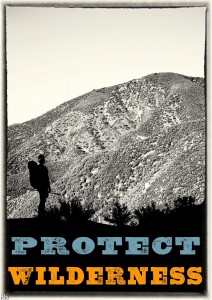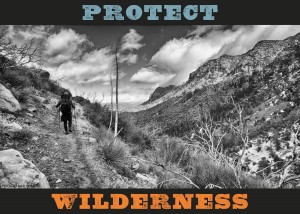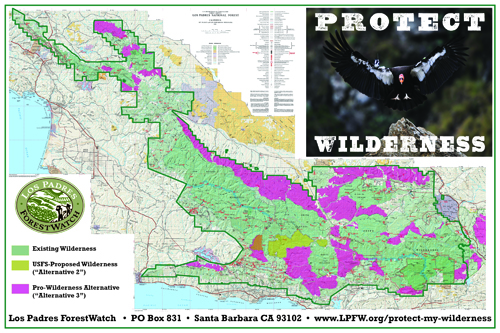 In February, the U.S. Forest Service announced that it would not recommend any new areas for wilderness protection in the Los Padres National Forest. Not one single acre.
In February, the U.S. Forest Service announced that it would not recommend any new areas for wilderness protection in the Los Padres National Forest. Not one single acre.
A coalition of forest users, local business leaders, elected officials, scientists, and other stakeholders are working together to ask the Forest Service to reconsider its “no-new-wilderness” policy. We want the Forest Service to recommend permanent wilderness protections for thousands of acres of forest land in the Santa Barbara, Ventura, and San Luis Obispo backcountry. Join us, and let your voice be heard!
Click here to learn more about the places at stake.
Background Info
In February, the U.S. Forest Service proposed long-awaited changes to the management plan for the Los Padres National Forest. While the proposed changes would prohibit motorized vehicles across more than 300,000 acres of forest land, the Forest Service failed to recommend a single acre for formal designation as “wilderness.” As a result, these areas remain vulnerable to development.
Recommending areas for wilderness designation is the first step towards securing permanent protection for these lands under the Wilderness Act of 1964. The Wilderness Act is America’s strongest land conservation tool – wilderness lands are forever protected from development. Camping, hiking, horseback riding, fishing, and hunting are all allowed in wilderness.
But the Forest Service’s proposed changes fall short of permanent protection. Instead of recommending these lands for wilderness designation, the Forest Service is proposing to zone them as Back County Non-Motorized (BCNM), leaving them vulnerable to development. Oil exploration and drilling, mining, communication facilities, “temporary” road construction, other energy development, and the disposal/sale of public land to private interests are all allowed on BCNM lands, but they are prohibited in areas recommended for wilderness designation.
 Last year, when the Forest Service first announced its “no-new-wilderness” policy for the Los Padres National Forest, thousands of local residents, wilderness advocates, forest users, and outdoor enthusiasts urged the Forest Service to recommend new wilderness areas. But when the Forest Service last month released a Draft Environmental Impact Statement (DEIS), it failed to make any changes to its original proposal. In the DEIS, the agency selects a Preferred Alternative (referred to as “Alternative 2”) that does not recommend a single acre for wilderness protection in the Los Padres National Forest. In the same document, the Forest Service rejects an alternative approach that emphasizes wilderness protection, called the Recommended Wilderness Emphasis (“Alternative 3”).
Last year, when the Forest Service first announced its “no-new-wilderness” policy for the Los Padres National Forest, thousands of local residents, wilderness advocates, forest users, and outdoor enthusiasts urged the Forest Service to recommend new wilderness areas. But when the Forest Service last month released a Draft Environmental Impact Statement (DEIS), it failed to make any changes to its original proposal. In the DEIS, the agency selects a Preferred Alternative (referred to as “Alternative 2”) that does not recommend a single acre for wilderness protection in the Los Padres National Forest. In the same document, the Forest Service rejects an alternative approach that emphasizes wilderness protection, called the Recommended Wilderness Emphasis (“Alternative 3”).
Our coalition supports a combination of Alternatives 2 and 3 for the Los Padres National Forest, ensuring that the most important lands are recommended for wilderness protection while allowing other uses in the remaining areas that are not suitable for wilderness designation.
The Forest Service accepted public comments on the DEIS and its Preferred Alternative until May 16, 2013, and ForestWatch allies voiced their support for increased wilderness protection in numerous areas of the Los Padres. The Forest Service anticipates finalizing the proposal later this summer.

Click here to download a .pdf edition.
Draft Environmental Impact Statement
LPNF Maps (DEIS Appendix 1)
- Antimony/Quatal (Ventura/Kern County)
- Black Mountain (San Luis Obispo County)
- Cuyama (Santa Barbara County)
- Dry Lakes (Ventura County)
- Fox Mountain (Santa Barbara County)
- Garcia Mountain (San Luis Obispo County)
- Machesna (San Luis Obispo County)
- Madulce/Buckhorn (Santa Barbara County)
- Sawmill-Badlands (Ventura/Kern County)
- Sespe-Frazier (Ventura County)
- Spoor Canyon (Santa Barbara County)
- Tequepis (Santa Barbara County)
- Diablo/Juncal/White Ledge (Ventura/Santa Barbara County)
LPNF Inventoried Roadless Area Evaluations (DEIS Appendix 2)
Monitoring Alternatives (DEIS Appendix 3)







Comments are closed.